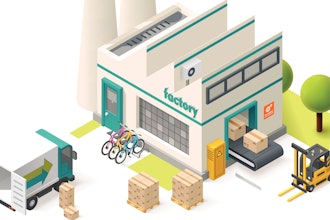
 For manufacturers, as in many industries, digital technologies are creating new opportunities, but also new challenges. Social, mobile, analytics, and cloud solutions can streamline production and speed time to market, enabling manufacturers to better customize and connect products to consumers. But these same forces put manufacturers under increasing pressure to innovate in order to survive and succeed. Simply installing new technology is not enough. To get a return on their investments, manufacturers need to put a business framework in place to support them. That requires transforming how they do business.
For manufacturers, as in many industries, digital technologies are creating new opportunities, but also new challenges. Social, mobile, analytics, and cloud solutions can streamline production and speed time to market, enabling manufacturers to better customize and connect products to consumers. But these same forces put manufacturers under increasing pressure to innovate in order to survive and succeed. Simply installing new technology is not enough. To get a return on their investments, manufacturers need to put a business framework in place to support them. That requires transforming how they do business.
Business transformation — fundamental change in processes, models, culture, and technology — is my job every day, but I know that for businesses, there’s nothing “everyday” about it. Transformation requires a serious investment of time, money and resources across all facets of an organization, and it can be a struggle to accomplish and reap the rewards. Earlier this year, to better understand how companies approach transformation, what works and what doesn’t, TCS commissioned Forrester Consulting to conduct a study, Business Transformation in a Digital Age. Forrester spoke with business transformation leaders and conducted an online survey of 100 US and UK decision makers with significant involvement in transformation projects.
The study found that senior executives understand that successful transformation doesn’t just require IT capabilities; in fact the key ingredients are primarily nontechnical skills to manage culture change and organizational design. In any large enterprise, even the biggest software change pales in comparison to the difficulty of getting buy-in and execution from everyone needed to make it work.
The research showed that in no industry is this challenge greater than in Manufacturing and Materials (MM), where executives were least likely to agree with the statement that, “My company is re-imagining new business models and/or customer interactions based on digital technologies” — only 40 percent, compared to 70 percent overall (across industries).
MM executives were unique in citing “employee resistance” and having “no mandate for change” as the biggest challenges faced during transformation projects, in contrast to executives in other industries such as financial services and business/consumer services, who were more likely to cite “cultural resistance” and “internal politics.” The high percentage for employee resistance may speak to the tension between an older generation who grew up on the factory floor, and a newer generation increasingly looking for digital solutions to digital problems.
When asked about the skills gaps that might hinder the successful implementation of a transformation project, MM executives were the most conscious of their gaps, by a wide margin, “leading” in 11 of 15 categories, including organizational design (73 percent), definition of roles and responsibilities (67 percent), and vision and strategy (67 percent).
Make no mistake — there is no industry for which transformation is easy or painless. A lot of business transformations miss the mark: projects take years longer than planned to complete, some are cancelled before any benefits are realized, and others simply under-deliver. The Forrester study found that almost half (47 percent) of enterprises saw a return on investment (ROI) from transformation projects of less than 10 percent. But for MM companies, that percentage jumps to 78 percent. Unlike executives from other industries such as financial services, no one in MM reported an ROI higher than 25 percent.
So what are the common elements that distinguish successful transformation projects from those that fail or disappoint? Here are some steps manufacturing companies can take to beat the odds:
- Invest in people and partners with the full set of “soft” skills needed.
Business and technology skills alone are not sufficient to ensure successful business transformations. Cultural change is often harder than updating technology, so companies need to be prepared with skills for organizational design, the management of culture change, defining roles and responsibilities, and incentivizing across the organization.
- Engage a partner who can help you get it done right. Business leaders look for partners whom they can trust, who are innovative and have the right mix of skills and capabilities and a proven track record of delivering operational excellence. Crucially, MM executives were by far the most likely to acknowledge that their organization lacked the skills and capabilities to manage transformation projects without a third-party partner.
- Tie together priorities, budgets and metrics across business and IT.
Siloing is fatal to the success of business transformation programs, which require interdependence between organizational groups. That means priorities for the project need to be clear and connected to the goals of both the business and IT organizations. Furthermore, budgets, metrics, and resource management should reflect those goals.
- Create a “T-suite” to oversee the program across all functions. To ensure an enterprise-wide perspective that considers the needs of various units and stakeholders across the organization, establish a “T-Suite” — an executive group within the enterprise comprised of representatives from all lines of business, who share ownership and management of the transformation program. Third-party partners should also be represented in the T-Suite.
- Update core systems, processes and data to support innovative initiatives.
Nearly all business transformations are enabled by software (79 percent of transformation leaders said that the design and implementation of software is an increasingly important component of a business transformation). Make sure that your transformation plan addresses the limits of your IT organization and infrastructure.
- Customize software solutions to match specific needs.
More than 54 percent of respondents reported that core business systems required at least a high level of customization, with one in five reporting very high customization requirements. Know when to standardize and when to invest in customization; striking the right balance requires high levels of business, technology and operational sophistication.
- Be flexible: measure, evaluate and adjust plans throughout the process.
The difference between those organizations that achieved high ROIs and those that had little-to-no ROI was in the willingness to make significant changes, based on metrics, as the project progressed. Create the right mix of IT and business metrics, re-evaluate and adjust for changing business conditions and new priorities. Above all, be open to self-criticism.
One of the big takeaways from the study is that you can’t invest heavily in IT and then expect to get away with “winging it” when it comes to change management. Change management is a science, not an art, and there’s expertise and a body of knowledge every company should be able to tap. If manufacturers want to remain both relevant and competitive, they need to take seriously the imperative to transform their businesses.
Krishnan Ramanujam is Global Head, Enterprise Solutions, Tata Consultancy Services, which comprises package implementation and consulting solutions on enterprise platforms.























